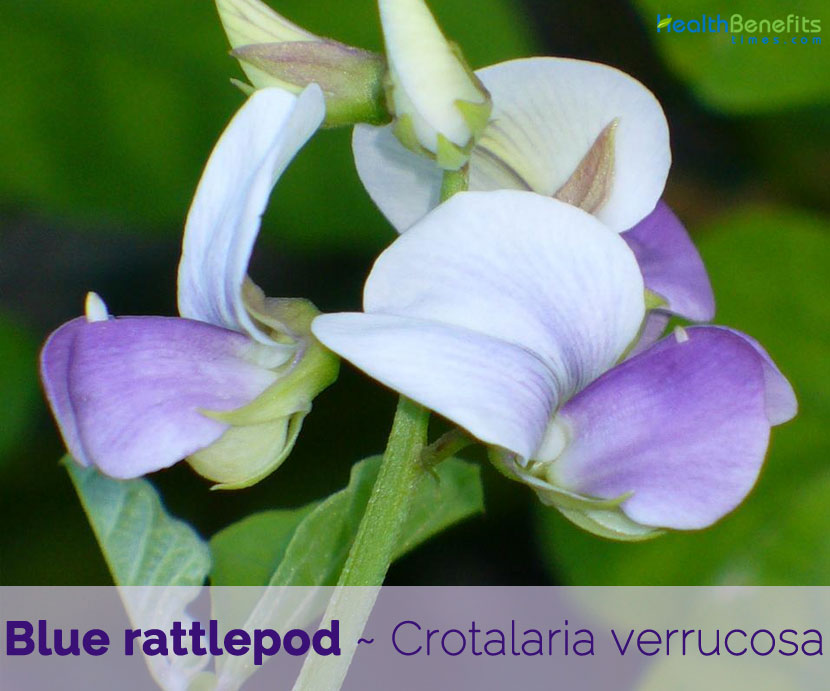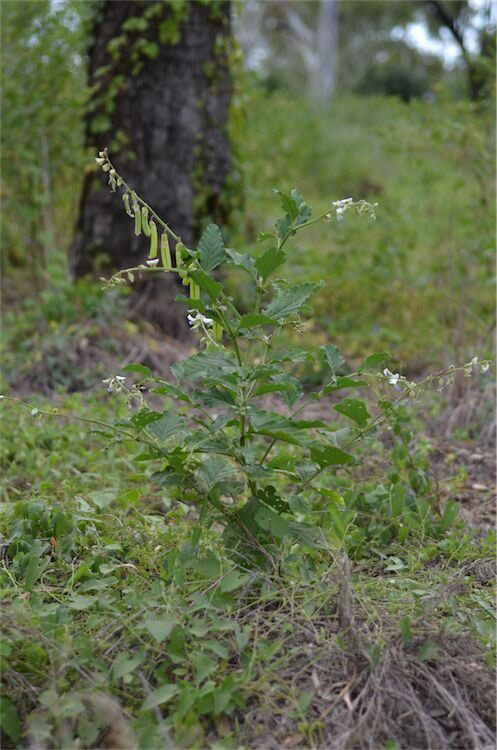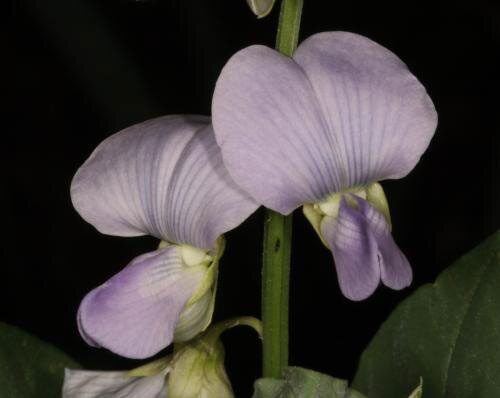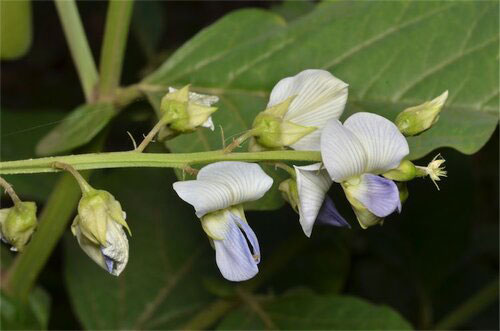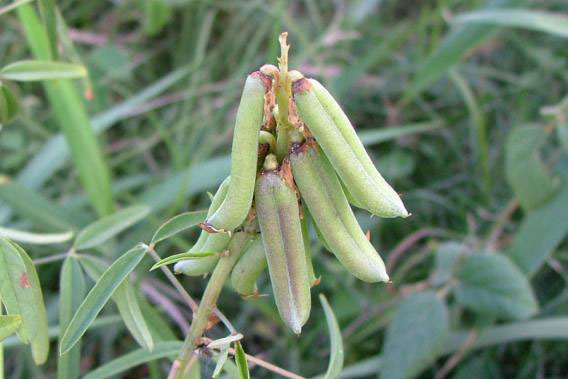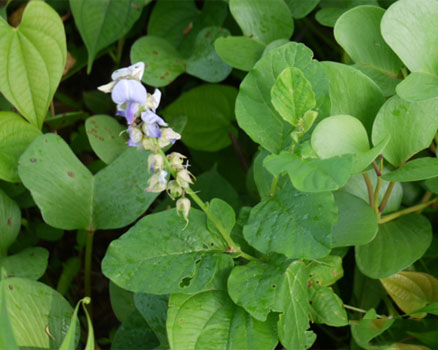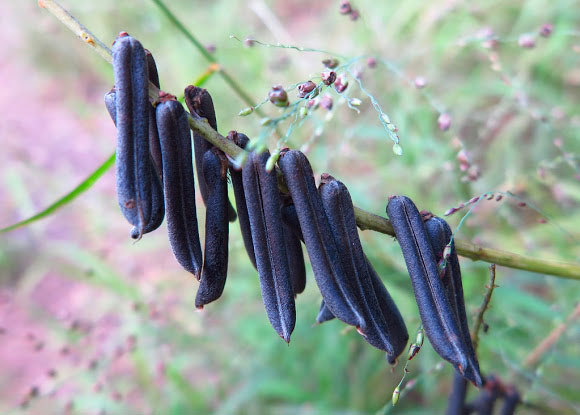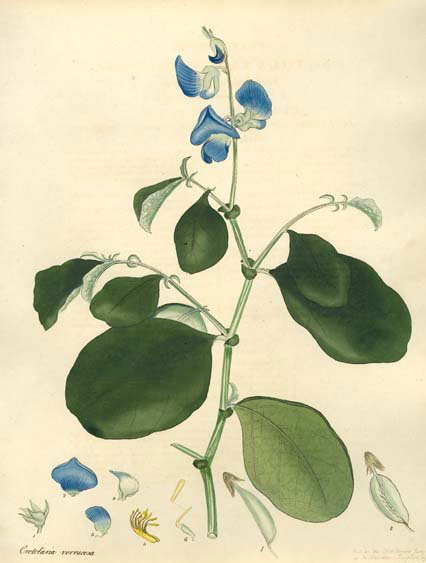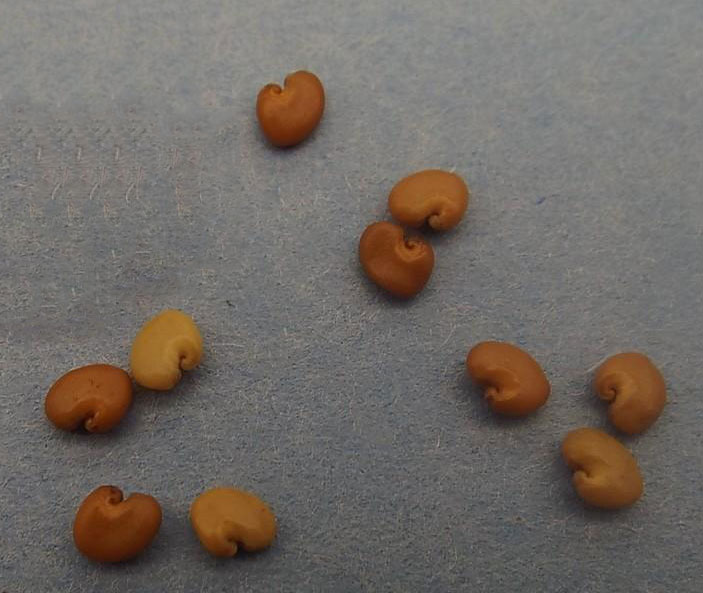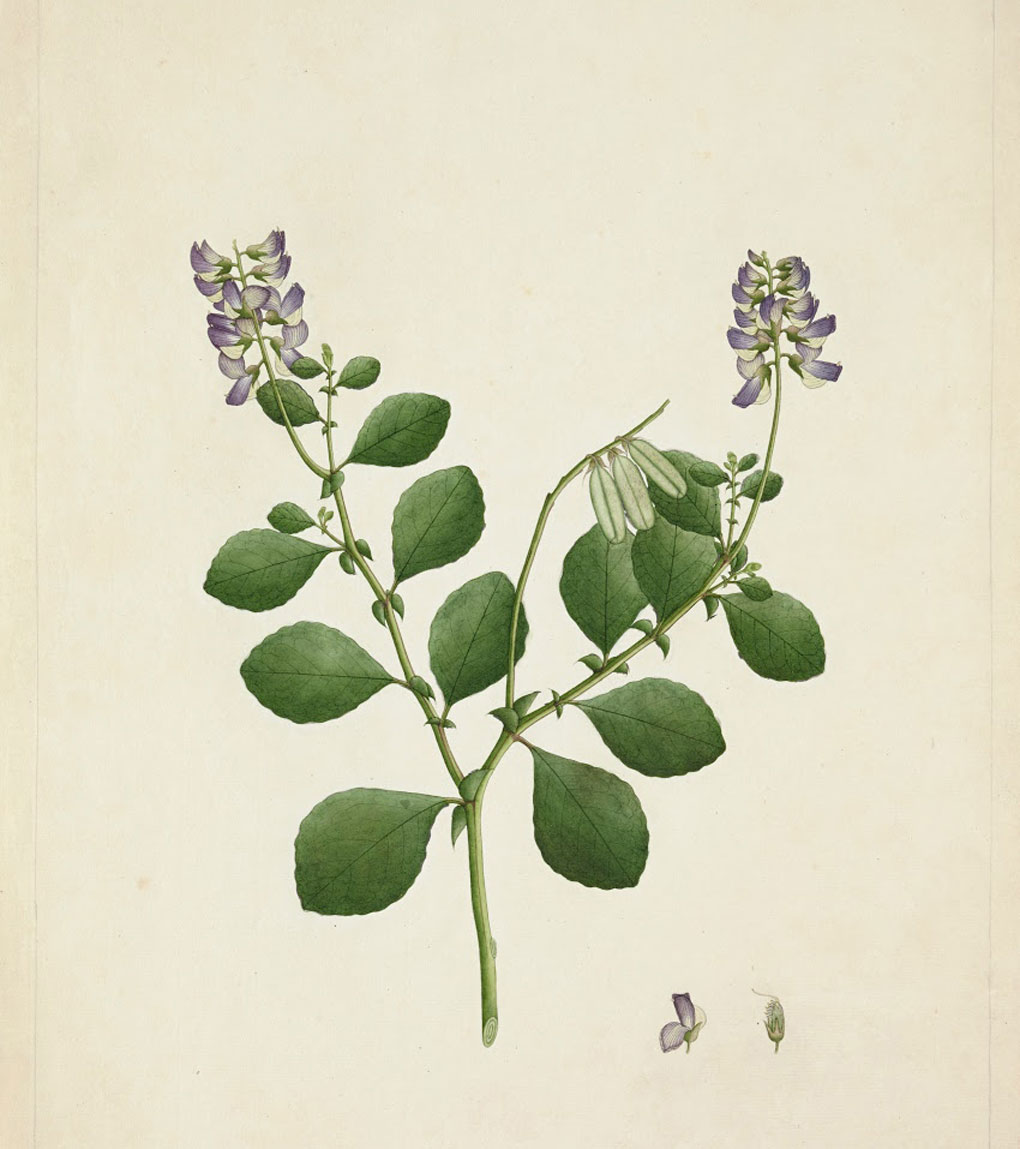Plant Description
Blue rattlepod is an erect or spreading, much-branched, annual, sub-woody plant that grows about 50 to 100 cm in height. The plant is found growing in fallow fields, marshy ground, along rivers, roads, Grassland, sparse forests, edges, open places in dry evergreen and deciduous forests. Stem is 4-angled, sulcate, shortly appressed or spreading pubescent. Twigs are 3 or 4 winged. Stipules are foliaceous, falcate, about 12-38 mm long and 13-31 mm wide, apex acuminate. Leaf blades are about 6.5-15 cm long and 3.5-5.5 cm wide, petioles are about 0.4-1 cm long, upper and lower surfaces are clothed in short white hairs. Lateral veins are about 7-13 on each side of the midrib.
Flowers
Flowers are subtended by narrow lanceolate, about 9 mm long, bracts, apex inflated and hooked. Flowers about 16-18 x 23 mm. Calyx tube is about 3-4 mm long, lobes about 6 mm long. Stamens ten, filaments fused into a tube about 6-7 mm long, open on one side. Petals: standard about 16 x 12 mm, wings about 12-15 mm long, keel about 12-15 mm long. Stamens dimorphic, the longer filaments with small anthers about 0.8 x 0.8 mm and the shorter filaments with longer anthers about 4 x 1 mm. Ovary densely clothed in white hairs. Style about 8-9 mm, hairy towards the apex. Flowering normally takes place from November.
Fruit
Fertile flowers are followed by cylindrical pods, about 50-80 mm long and 10-16 mm wide, hairy, grooved on one side. Seeds are about 28-32 per fruit. Outer surface of the seeds and the inner surface of the pod are oily. Radicle is adjacent to the cotyledons.
Traditional uses and benefits of Blue Rattlepod
- Leaf paste is applied to cure headaches.
- The roots are used as a treatment against fever and stomach pains.
- The plant is blood purifier, emmenogogue. It is used to purify the blood and to cure skin diseases.
- Roots are used against fever and stomach pain.
- The leaves are expectorant and emetic; cure biliousness, dyspepsia, fever, throat and mouth diseases and heart complaints.
- It is used both internally and externally for scabies and impetigo and in diminishing salivation.
- Leaf extract is applied to soothe skin allergies.
References:
https://www.itis.gov/servlet/SingleRpt/SingleRpt?search_topic=TSN&search_value=501811#null
http://www.hear.org/pier/species/crotalaria_verrucosa.htm
https://npgsweb.ars-grin.gov/gringlobal/taxonomydetail.aspx?id=12396
https://indiabiodiversity.org/species/show/229374
https://www.wikidata.org/wiki/Q10932824
https://wikivisually.com/wiki/Crotalaria_verrucosa
https://plants.usda.gov/core/profile?symbol=CRVE5
https://en.wikipedia.org/wiki/Crotalaria_verrucosa
http://www.plantsoftheworldonline.org/taxon/urn:lsid:ipni.org:names:489042-1
http://tropical.theferns.info/viewtropical.php?id=Crotalaria+verrucosa
https://uses.plantnet-project.org/en/Crotalaria_verrucosa_(PROSEA)
http://tropical.theferns.info/viewtropical.php?id=Crotalaria%20verrucosa
http://www.canbr.gov.au/cpbr/cd-keys/RFK7/key/RFK7/Media/Html/entities/Crotalaria_verrucosa.htm
Comments
| Blue rattlepod Quick Facts | |
|---|---|
| Name: | Blue rattlepod |
| Scientific Name: | Crotalaria verrucosa |
| Origin | Bangladesh, China, Cambodia, India, Indonesia, Laos, Malaysia, Myanmar, Nepal, Philippines, Sri Lanka, Thailand, Vietnam |
| Colors | Yellowish to brownish |
| Shapes | Oblong pod, 3–4 cm long, 9–12 mm thick, apressed pubescent or with spreading brown hairs |
| Taste | Bitter, astringent, sour |
| Health benefits | Beneficial for headaches, fever, stomach pains, dyspepsia, throat, mouth diseases, heart complaints, scabies, impetigo |
| Name | Blue Rattlepod |
|---|---|
| Scientific Name | Crotalaria verrucosa |
| Native | Bangladesh, China, Cambodia, India, Indonesia, Laos, Malaysia, Myanmar, Nepal, Philippines, Sri Lanka, Thailand, Vietnam; Australasia and Africa & Americas regions |
| Common Names | Sweet Pea, Warty Crotalaria, Tooth-Leaved Rattlepod, Blue-Flowered Rattlepod, Blue Rattlepod, Blue Rattlesnake, Warty Rattlebox, Blue Rattleweed, blue-flowered crotalaria, purple popbush, shack-shack, tooth-leaf rattlepod, Blue Andana, Purple Rattlebox, Warted Crotalaria, Blue Rattle-box, Cascavelle á Fleurs Bleues |
| Name in Other Languages | Bengali: Bansana (বনশণ), Naśaṇa (নশণ) Cambodia: voë(lli) châ:ng, khnâ:ng prâmat, châ:ngkrâ:ng tma:t Chinese: Dà yè yě bǎi hé (大 葉野百合), Duō yóu zhū shǐ dòu (多疣猪屎豆) English: Blue-flowered crotalaria, Blue-flowered rattlepod, Blue rattlesnake, Blue rattleweed, Purple pupbush, Purple rattlebox, Shack-shack, Sweet pea, Tooth-leaved rattlepod, Warty crotalaria, Warty rattlebox, blue-flower rattlepod, tooth-leaf rattlepod, blue andana, warted Croralaria, Blue-flower rattlepod, blue andana, French: Cascavelle bleue, Cascavelle à fleurs bleues, Crotalaire à fleurs bleues, Pois-zombi, Sonnette bleue, Tcha-tcha bleu, Cascavelle Bleu, Cascavelle a Fleurs Blanches, Gujarati: Ghugharo (ઘૂઘરો) Hindi: Banshan (बनशण), Jhunjhunia (झुनझुनिया), bansam, shanpushpi Irula: Kolingi Japanese: Kurotararia akuminaata (ク ロタラリア・アクミナータ ), Ku rotararia vu~eru Kosa (ク ロタラリア・ヴェル コサ ) Kurotararia verukosa, Ku rotararia angurosa (ク ロタラリア・アングロサ) Kannada: Gijigiji gida (ಗಿಜಿಗಿಜಿ ಗಿಡ), giji-giji gida, gijibeeji, gijigiji gida, gijigiji soppu, gilanganchi gida, gilangicchu, ginagigiji gida, thannele gida, ulukina gida Konkani: Kilukiluppai, bhat ghagari (भाट घागरी) Laos: Ko hnha:z lem (Houa Pan) Malay: Kacang reriang Malaysia: Gegiring jantan Malayalam: Kilukilukki (കിലുകിലുക്കി), Kilukiluppa (കിലുകിലുപ്പ), pee-tandale-cotti Marathi: Bhat ghagari (भाट घागरी), Khulkhula (खुळखुळा), Sagar tag (सागर ताग), bomb, ghagaree, ghagari, ghagharu, khulkulaa, san, tag, thirat Nepali: Shobhaapushp (शोभापुष्प) Philippines: Bulai laua, gulinggam (Sulu), reging (Bagobo) Burma (Myanmar): Hing hai bay yai Russian: Krotaliariia verrukoznaia (Кроталярия веррукозная) Sanskrit: Brihatpuspi (बृहत्पुष्पी), Ghaṇṭāravā (घण्टारवा), Shanapuspi (शणपुष्पी), Śaṇapuṣpikā (शणपुष्पिका), Brihatapushpi Sinhalese: Jac Beerie Gha, Nil-andana-hiriya, Yak Bariye Spanish: Cascabelillo, Cascabelito, Chochito, Crotalaria lengua de vaca Tamil: Cankuniti (சங்குநிதி), Kilu-kiluppai (கிலுகிலுப்பை), Pakaṉṟai (பகன்றை), Gilugiluppai,Salangaichedi, amparanemi, amparanemicceti, avaratimatu, calcalamatar, cankuniti, cankunti, cantatakacceti, cantatakam, guluglluppaichedi, iratimatu, iratimatucceti, kalimakam, kalimarakacceti, kalimarakam#, kalimarakam@, kappi, kaucikeyam, killukiluppai, kilu kulppai, kilukiluppai, kilunki, kuttanacani, matavalaki, mavatalaki, narimarutti, narimerutti, narimiratti, nariverutti, otai, pakanrai, pakanraicceti, pancapatcivaci, peetandale-cotti, pemiratti, peymiratti, peymocci, peyppalamiratti, peyppalamiratti, peyppalamiratticceti, piccai, pittantalaikkotti, tampalakkarutam, tantalaikkotti, tanti, ulanku, ulankucceti, uttelanacceti, uttelanam, vami, vattakillu killuppai, vattakilukiluppai, vattakkilukiluppai, vattanarimiratti, vattanariviratti, vellaikkilukiluppai, venkilukiluppai, venkilukiluppaicceti, vilupannivilu, vitaikalikacceti, vitaikalikam Telegu: Giliginta (గిలిగింత), Ghelegherinta, alla galli gheetsa, alla gili giccha, ghalegherinta, gheli-gherinta, gilagoranta, gili gicha Thai: Hing hai bai yai (หิงหายใบใหญ), Kra pho phi (กระเพาะผี), Mak hing nu (หมากหิ่งหนู) Tulu: Gijigiji dai (ಗಿಜಿಗಿಜಿ ದೈ) Vietnam: Sục sạc |
| Plant Growth Habit | Erect or spreading, much-branched, annual, sub-woody plant |
| Growing Climates | Fallow fields, marshy ground, along rivers, roads, Grassland, sparse forests, edges, open places in dry evergreen and deciduous forests |
| Plant Size | About 50 to 100 cm in height |
| Stem | Stem 4-angled, sulcate, shortly appressed or spreading pubescent |
| Leaf | Simple; blade ovate to elliptic, up to 5·5–12·5 cm. long, 4·5–8 cm. wide, thinly appressed or spreading pubescent on both surfaces; petiole ± 4–9 mm. long |
| Flowering season | November |
| Flower | Occur in 10-12 flowered racemes at the end of branches or laterally. The racemes are typically 15-20 cm long. Flower tube is about 2 cm, bluish purple and white. “Standard” petal 1.5 cm, obovate, veined with dark purple lines |
| Fruit Shape & Size | Oblong Pod, 3–4 cm long, 9–12 mm thick, apressed pubescent or with spreading brown hairs |
| Fruit Color | Yellowish to brownish |
| Seed | Oblique-cordiform, with the narrow end strongly incurved, practically smooth to distinctly papillose, shiny, brown. |
| Propagation | By Seed |
| Taste | Bitter, astringent, sour |
| Plant Parts Used | Leaves, flowers, root, whole plant, seed |
| Other Facts |
|
| Precautions |
|


